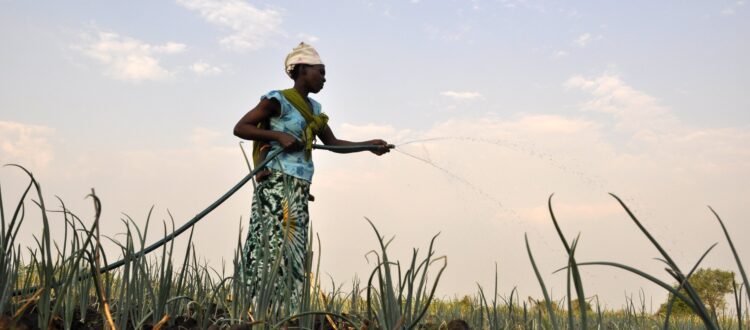THE INTERCONNECTION BETWEEN FOOD, ENERGY, AND WATER: A SYSTEMIC VIEW
Food, energy, and water are essential resources for human life on Earth and are highly interconnected. For instance, agriculture, with its significant global impact, accounts for about 70% of total freshwater withdrawals [1]. This sector is the largest user of water resources worldwide, demonstrating how water is a crucial component of the food chain, involving agricultural production, forestry, and fishing.
On the other hand, energy plays a vital role, contributing substantially to meeting global needs. It is estimated that the complex food production and supply system requires about 30% of the total energy consumed worldwide [2]. This energy is used in various stages, from the production process to the transportation and distribution of food, and is also essential for operations such as extraction, pumping, lifting, harvesting, transportation, and treatment of water resources.
In this context, the complex interdependence between these fundamental resources is clear, emphasizing the need to adopt a systemic approach to fully understand the impact of each on the others. It is within this framework that the concept of the water-energy-food nexus takes shape, proving extremely useful in describing and addressing the complexity and interconnectedness of our planet, which underpins a range of social, economic, and environmental objectives.
Practically, the water-energy-food nexus provides a conceptual framework that allows for a better understanding and systematic analysis of the intricate interactions between the natural environment and human activities. This approach promotes more coordinated management and use of natural resources, involving different sectors and levels of scale. Furthermore, this systemic approach offers the opportunity to identify and manage trade-offs between these resources and to develop synergies through our responses, thus enabling more integrated and cost-effective planning, decision-making, implementation, monitoring, and evaluation [3].
Large-scale water infrastructure projects, for example, can have synergistic impacts, producing hydroelectric power and providing water storage for irrigation and urban uses. However, this could come at the expense of downstream agroecological systems and with social implications, such as resettlements. Similarly, the cultivation of bioenergy crops in an irrigated agricultural scheme can help improve energy supply and generate employment opportunities, but it can also lead to increased competition for land and water resources, with implications for local food security [4].
The FAO (Food and Agriculture Organization of the United Nations) has identified three areas of work to identify, assess, and manage interactions between nexuses, considering the impacts that any change – a policy decision, a large-scale investment, or a change in agricultural practices – may have beyond the intended objectives and scale.
These areas of work are evidence, scenario development, and response options [4]. These areas do not describe a linear set of phases but are complementary areas of work, interconnected by dialogue with stakeholders.
Evidence, i.e., data: is needed to assess and analyse nexus interactions and the data collected. They must be reliable, relevant, and timely. Linking with existing and planned observation systems worldwide and supporting the development of new systems, tools, and services is essential [5].
Scenario development: explores strategic issues, reviews policies and investment decisions, and serves to create a “common ground” and a better understanding of the interrelationships between water, energy, and food and the underlying factors. Scenarios describe a set of multiple and equally plausible future developments in an inherently uncertain world [4].
Response options: refers to planning and implementing new policies, investments, regulations, and incentives (such as subsidies, promoting appropriate business models, institutional mechanisms, financial instruments and funds/financing structures, legislation, policy tools, and support), capacity development and training, and technical interventions. It also includes the process of evaluating and comparing the impacts of different interventions [4].
In the context of climate change, this integrated approach provides a conceptual framework, essential for understanding complex interconnections and identifying possible solutions. The food-energy-water nexus approach provides interesting insights for evaluating possible mitigation and adaptation strategies for food security, and resource supply, as well as developing integrated solutions to enhance community resilience and contribute to the conservation of natural resources.
Article by Bruna Anzà, Volunteer at the Italian Climate Network
Bibliography
[1] FAO. 2011a. The state of the world’s land and water resources for food and agriculture (SOLAW) – Managing systems at risk. Rome: Food and Agriculture Organization of the United Nations and London, Earthscan.
[2] FAO. 2011b. Energy-smart food for people and climate. Issue Paper. Rome: Food and Agriculture Organization of the United Nations.
[3] FAO (2014) The Water-Energy-Food Nexus—A New Approach in Support of Food Security and Sustainable Agriculture. Food and Agriculture Organization of the United Nations, Rome.
[4] FAO. 2012a. Energy-Smart Food at FAO: An Overview. Environment and Natural Resources Management Working Paper No. 53. Rome: Food and Agriculture Organization of the United Nations.
[5] Clark et al. 2013. NAF-SAR Workflow. Working Draft. University of Southampton and FAO, Rome

